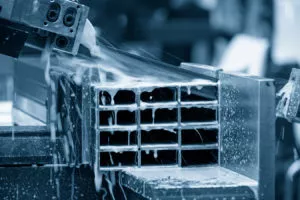Cutting through metal has never been safer or more precise thanks to hydraulic vise systems. In this article, you’ll learn how hydraulic pressure and automated controls enhance safety and efficiency during bandsaw operations. We’ll break down key technical insights, step-by-step cutting processes, and maintenance tips, providing you with a clear roadmap to optimize your bandsaw performance.
Mastering Safe and Efficient Bandsaw Cutting with Hydraulic Vise Systems
The Role of Hydraulic Vise Systems in Bandsaw Operations
Hydraulic vise systems are integral components of modern bandsaw machines, enhancing both functionality and performance. These systems utilize hydraulic pressure to securely clamp workpieces, allowing for precise and stable cutting operations. Historically, the evolution of bandsaw technology has seen a shift from manual clamping methods to hydraulic systems, which offer significant improvements in efficiency and safety. According to a study by the American Society of Mechanical Engineers, the introduction of hydraulic vises has reduced setup times by up to 30%, enabling faster production cycles.
In a hydraulic vise, the clamping force is generated by hydraulic cylinders, which can be adjusted to accommodate various material sizes and shapes. This adaptability is crucial in industrial settings where different materials are processed. The hydraulic system not only provides a strong grip but also allows for quick adjustments, minimizing downtime during operations. The integration of hydraulic vises has transformed bandsaw cutting from a labor-intensive task to a streamlined process, significantly enhancing productivity.
Key Safety Advantages Offered by Hydraulic Control
One of the primary safety benefits of hydraulic controls in bandsaw operations is the enhanced pressure regulation they provide. Unlike manual systems, hydraulic vises can maintain consistent clamping pressure, reducing the risk of workpieces slipping during cutting. This stability is vital for preventing accidents and ensuring operator safety. Additionally, hydraulic systems can be equipped with pressure sensors that automatically adjust the clamping force based on the material being cut, further enhancing safety.
Controlled feed rates are another safety feature of hydraulic systems. By regulating the speed at which the blade descends, operators can avoid excessive force that could lead to blade breakage or kickback. Automated adjustments in hydraulic systems also minimize the need for manual intervention, reducing the likelihood of operator error. A report from the National Institute for Occupational Safety and Health (NIOSH) highlights that workplaces utilizing hydraulic systems have reported a 40% decrease in cutting-related injuries.
Efficiency and Precision: How Hydraulic Vises Optimize Cuts
Hydraulic vises significantly enhance the efficiency and precision of bandsaw cutting. By minimizing the need for manual adjustments, these systems allow for consistent and repeatable cuts, which is essential in high-volume production environments. The ability to quickly secure and release workpieces means that operators can focus on monitoring the cutting process rather than spending time on setup.
Moreover, hydraulic vises can accommodate a wide range of materials and thicknesses, ensuring that each cut is optimized for the specific workpiece. This adaptability not only improves cut quality but also reduces material waste. According to a study published in the Journal of Manufacturing Science and Engineering, integrating hydraulic vises can lead to a 25% increase in cutting efficiency, translating to significant cost savings over time.
Technical Insights into Hydraulic Pressure and Feed Control
The operational performance of hydraulic vise systems is heavily influenced by the settings of hydraulic pressure and feed control. Variations in hydraulic pressure can affect the clamping force, which in turn impacts the stability of the workpiece during cutting. For instance, a case study involving a manufacturing facility showed that adjusting the hydraulic pressure to match the material’s density resulted in a 15% improvement in cut accuracy.
Feed control settings are equally critical. A slower feed rate may be necessary for harder materials to prevent blade wear, while softer materials can be cut at higher speeds. Real-world applications have demonstrated that optimizing these settings can lead to a reduction in blade replacement frequency, further enhancing operational efficiency. The ability to fine-tune these parameters is a hallmark of modern hydraulic systems, making them indispensable in today’s manufacturing landscape.
A hydraulic vise system in bandsaw cutting is like having a clingy, overprotective friend who just won’t let go—ensuring every cut is perfectly safe and oh-so-precise!
Step-by-Step Operational Processes for Precision Bandsaw Cuts
Defining a Correct Cutting Sequence for Consistent Results
To achieve consistent and precise cuts with a bandsaw, it is essential to establish a reliable cutting sequence. This sequence should encompass all necessary preparations, timing, and operations. Here’s a step-by-step approach:
- Preparation: Begin by selecting the appropriate saw blade based on the material type and thickness. Ensure that the blade is sharp and properly tensioned.
- Setup: Secure the workpiece in the vise, ensuring it is aligned correctly with the blade path. Adjust the vise to hold the workpiece firmly without causing deformation.
- Timing: Allow the saw to reach full speed before initiating the cut. This ensures optimal cutting efficiency and reduces the risk of blade damage.
- Monitoring: Continuously observe the cutting process, paying attention to the quality of the chips produced. Adjust the feed rate and downfeed pressure as necessary to maintain cut quality.
Selecting the Ideal Saw Blade and Adjusting Workpiece Setup
Choosing the right saw blade is crucial for effective cutting. Consider the following factors:
- Blade Type: For metal cutting, bi-metal or carbide blades are recommended for their durability and cutting efficiency.
- Teeth Per Inch (TPI): Select a higher TPI for thinner materials to achieve a cleaner cut. For thicker materials, a lower TPI is more effective.
- Alignment Techniques: Ensure the blade is aligned with the workpiece by adjusting the blade guides. The guides should be set close to the workpiece without making contact.
Properly securing and positioning the workpiece is equally important. Use the vise to clamp the workpiece securely, ensuring it does not move during the cutting process.
Integrating Bow Downfeed and Hydraulic Assistance
Combining manual or gravity-based downfeed systems with hydraulic assistance can significantly enhance control during cutting. Here’s how to effectively integrate these systems:
- Adjusting Downfeed Pressure: Set the hydraulic downfeed pressure according to the material being cut. This allows for a consistent feed rate, improving cut quality.
- Equipment Settings: Ensure that the hydraulic system is properly calibrated. Regularly check for leaks and maintain fluid levels to ensure optimal performance.
- Combining Systems: If using a manual downfeed, ensure that the hydraulic system can take over when needed, providing additional support for heavier cuts.
Monitoring Chip Production to Ensure Cut Quality
Monitoring chip production is vital for maintaining cut accuracy. Here are some practical tips:
- Chip Characteristics: Ideal chips should be thin, curled, and silvery. If chips are thick or discolored, it may indicate incorrect feed rates or blade issues.
- Debris Removal: Regularly clear chips from the cutting area to prevent interference with the cutting process. A clean workspace enhances safety and efficiency.
- Troubleshooting: If cut quality deteriorates, check blade tension, alignment, and downfeed pressure. Adjust these parameters as necessary to restore optimal cutting conditions.
Best Practices for Maintaining Bandsaw Performance and Hydraulic Systems
Routine Blade and Vise Inspections to Prevent Failures
Regular inspections of the bandsaw blade and vise are crucial for ensuring optimal performance and preventing unexpected failures. A systematic approach to inspections can significantly extend the life of both the blade and the machine.
Key areas to examine include:
- Blade Condition: Check for signs of wear, such as dullness or damage. Inspect the teeth for chips or breaks, and replace the blade if necessary.
- Blade Tension: Ensure the blade is properly tensioned. Incorrect tension can lead to poor cutting performance and blade failure.
- Vise Alignment: Verify that the vise jaws are aligned correctly and securely clamped. Misalignment can cause crooked cuts and increase wear on the blade.
- Frequency of Checks: Conduct these inspections before each use and perform a more thorough check weekly or bi-weekly, depending on usage intensity.
Hydraulic Maintenance: Checking Fluid, Filters, and Pressure
Maintaining the hydraulic system is essential for the smooth operation of bandsaws equipped with hydraulic vises and downfeed systems. Regular checks can prevent costly repairs and ensure consistent performance.
Actionable steps for hydraulic maintenance include:
- Fluid Level Checks: Regularly monitor the hydraulic fluid level to prevent air from entering the system, which can lead to erratic operation.
- Filter Replacements: Change hydraulic filters every six months to avoid sediment buildup that can block lines and reduce pressure.
- Pressure Monitoring: Use a pressure gauge to ensure the hydraulic system operates within the manufacturer’s specified range, typically between 1,500 to 3,000 psi for most bandsaws.
Coolant Management: Ensuring Optimal Blade Performance
Effective coolant management is vital for maintaining blade temperature and lubrication during cutting operations. A well-maintained coolant system can enhance blade life and improve cut quality.
Key maintenance routines for coolant management include:
- Regular Fluid Replacement: Change the coolant regularly to prevent contamination and ensure optimal performance.
- Coolant Ratio Checks: Maintain the correct mixture of cutting oil and water, typically around 5-10% oil concentration, using a refractometer for accuracy.
- Filter Cleaning: Clean or replace filters in the coolant system to prevent clogs that can disrupt flow and cooling efficiency.
- Tank Maintenance: Regularly clean the coolant tank to remove chips and debris that can affect fluid quality.
Troubleshooting Common Mechanical and Hydraulic Issues
Identifying and resolving common mechanical and hydraulic issues can save time and prevent further damage to the bandsaw. Here are some troubleshooting strategies:
- Blade Binding: If the blade binds during cutting, check for misalignment in the vise or blade guides. Adjust as necessary to ensure smooth operation.
- Inconsistent Cutting Speed: Fluctuations in cutting speed may indicate low hydraulic pressure. Check fluid levels and filters to ensure proper flow.
- Excessive Vibration: Vibration can result from worn bearings or misaligned components. Inspect and replace any damaged parts to restore stability.
- Case Study: A shop experienced frequent blade breakage due to improper tensioning. After implementing a routine inspection schedule, blade life increased by 50%.
Innovations and Future Trends in Bandsaw and Hydraulic Vise Technology
Emerging Features in Hydraulic Downfeed and Vise Systems
Recent advancements in hydraulic downfeed and vise systems are revolutionizing bandsaw technology, enhancing both performance and safety. One notable innovation is the integration of variable pressure control in hydraulic systems, allowing for precise adjustments based on the material being cut. For instance, modern hydraulic vises can automatically adjust clamping pressure to accommodate different workpiece sizes and materials, reducing the risk of slippage and ensuring a secure grip.
Additionally, some systems now feature real-time monitoring capabilities that provide feedback on hydraulic fluid levels and pressure, alerting operators to potential issues before they escalate. This proactive approach not only enhances safety but also minimizes downtime. For example, the use of sensors in hydraulic systems can detect abnormal pressure fluctuations, prompting immediate adjustments to maintain optimal cutting conditions.
Furthermore, advancements in materials used for hydraulic components, such as high-strength alloys and composites, are improving durability and reducing maintenance needs. These innovations contribute to longer service life and lower operational costs, making hydraulic bandsaws more efficient and reliable.
Market Trends Influencing Bandsaw Safety and Efficiency
The bandsaw market is currently influenced by several key trends that prioritize safety and efficiency. One significant trend is the increasing demand for automation in manufacturing processes. As industries strive for higher productivity, bandsaws equipped with automated features, such as programmable cutting sequences and automatic material handling, are becoming more prevalent.
According to a recent market analysis, the global bandsaw market is projected to grow at a CAGR of 5.2% over the next five years, driven by the need for precision cutting in various sectors, including automotive and aerospace. This growth is prompting manufacturers to innovate and enhance safety features, such as improved blade guards and emergency stop mechanisms, to comply with stricter industry regulations.
Moreover, the rise of eco-friendly practices is influencing the design of bandsaws. Manufacturers are increasingly focusing on energy-efficient motors and hydraulic systems that reduce power consumption, aligning with sustainability goals. This shift not only meets regulatory requirements but also appeals to environmentally conscious consumers.
User Experience Enhancements through Digital Controls
The integration of digital controls in modern bandsaws is significantly enhancing user experience and operational efficiency. Advanced control panels now feature touch-screen interfaces that allow operators to easily adjust settings, monitor performance, and receive real-time feedback on cutting conditions. This user-friendly approach reduces the learning curve for new operators and minimizes the risk of operational errors.
Additionally, the implementation of IoT (Internet of Things) technology in bandsaws enables remote monitoring and diagnostics. Operators can access machine data from their smartphones or computers, allowing for timely maintenance and troubleshooting. For instance, predictive maintenance algorithms can analyze usage patterns and alert users when components are likely to require servicing, thereby preventing unexpected breakdowns.
Furthermore, the incorporation of augmented reality (AR) in training programs is revolutionizing how operators learn to use bandsaws. AR applications can overlay digital information onto the physical machine, guiding users through setup and operation processes in real-time, which enhances safety and efficiency.
Looking Ahead: The Future of Metal Cutting Technologies
As technology continues to evolve, the future of metal cutting processes is poised for significant advancements. One potential development is the increased use of artificial intelligence (AI) in bandsaw operations. AI algorithms could optimize cutting parameters based on real-time data, improving efficiency and reducing material waste. For example, AI could analyze the type of material and its thickness to automatically adjust blade speed and downfeed pressure for optimal cutting performance.
Moreover, the trend towards fully automated manufacturing environments suggests that bandsaws will increasingly be integrated into larger production systems, working in tandem with robotics and other automated machinery. This integration will streamline workflows and enhance overall productivity.
Case studies from leading manufacturers indicate that the adoption of smart bandsaws equipped with AI and machine learning capabilities can lead to a 30% reduction in operational costs and a significant increase in cutting precision. Expert commentary from industry leaders emphasizes the importance of staying ahead of these trends to remain competitive in the evolving market.
Optimizing Hydraulic Vise Integration for Superior Cutting Performance
Practical Adjustments for Feed Rate and Vise Pressure
Calibrating the feed rate and adjusting vise pressure are critical for achieving optimal performance in hydraulic vise systems. Start by determining the material type and thickness, as these factors significantly influence the required feed rate. For instance, softer materials like aluminum can be cut at higher feed rates, while harder materials like stainless steel require slower rates to prevent blade wear.
Experts recommend setting the initial feed rate at approximately 50% of the machine’s maximum capability and then adjusting based on the quality of the cut. If the chips produced are too fine or powdery, it may indicate that the feed rate is too high. Conversely, if the chips are thick and stringy, the feed rate may need to be increased.
For vise pressure, a good starting point is to apply enough force to hold the workpiece securely without deforming it. A pressure gauge can help monitor this, with typical settings ranging from 500 to 1,500 psi, depending on the material and thickness. Regularly check the alignment of the vise jaws to ensure they are perpendicular to the blade, as misalignment can lead to inaccurate cuts.
Case Studies: Successful Implementations of Hydraulic Vises
One notable case study involves a manufacturing facility that integrated hydraulic vises into their bandsaw operations. Initially facing challenges with inconsistent cut quality and material wastage, the facility decided to upgrade to hydraulic vises with adjustable pressure settings. After implementation, they reported a 30% reduction in material waste and a significant improvement in cut accuracy.
Another example comes from a metal fabrication shop that struggled with operator fatigue due to manual vise adjustments. By switching to a hydraulic system, they not only enhanced cutting efficiency but also reduced operator strain. The measurable results included a 25% increase in productivity and a notable decrease in operator injuries related to manual handling.
Addressing and Preventing Operational Challenges
To ensure smooth operation of hydraulic vises, consider the following troubleshooting and preventive strategies:
- Regularly inspect hydraulic fluid levels and replace filters to prevent contamination.
- Monitor for leaks in hydraulic lines and fittings, addressing any issues immediately.
- Ensure that the vise jaws are clean and free from debris to maintain proper clamping force.
- Calibrate the hydraulic pressure settings periodically to adapt to different materials.
- Train operators on the correct use of hydraulic systems to minimize misuse and accidents.
Advanced Settings for Custom Cutting Requirements
Hydraulic vise systems offer customizable settings that can be fine-tuned for specific cutting challenges. For instance, operators can adjust the downfeed rate to accommodate different material densities, allowing for a more controlled cutting process. This is particularly useful when transitioning between materials like aluminum and high-carbon steel.
Additionally, advanced hydraulic systems may include programmable logic controllers (PLCs) that allow for precise control over feed rates and pressure settings. Operators can set different profiles for various materials, ensuring optimal performance without the need for constant manual adjustments. Expert tips suggest utilizing these programmable features to create a library of settings for frequently cut materials, streamlining the setup process for future jobs.
Elevating Safety Protocols and Operational Guidelines in Bandsaw Use
Mandatory Safety Equipment and Personal Protective Measures
Operating a bandsaw requires strict adherence to safety protocols to protect the operator and ensure efficient cutting. Essential safety equipment includes:
- Safety Glasses: Protects eyes from flying debris and sparks.
- Hearing Protection: Earplugs or earmuffs are crucial, as bandsaws can produce noise levels exceeding 100 decibels.
- Gloves: Cut-resistant gloves should be worn to protect hands from sharp edges, but they must be snug to avoid snagging.
- Steel-Toed Boots: These provide foot protection against heavy materials and equipment.
- Face Shields: In addition to safety glasses, face shields can offer extra protection against flying particles.
Operators should also wear fitted clothing, avoiding loose garments that could get caught in moving parts. Regular training on the use of personal protective equipment (PPE) is essential to maintain a safe working environment.
Pre-Cutting Safety Checks for Machine and Workpiece Stability
Before initiating any cutting operation, a thorough pre-cutting safety inspection is vital. Here’s a checklist to ensure both the machine and workpiece are secure:
- Check that all safety guards are in place and functioning.
- Inspect the blade for any signs of wear or damage.
- Ensure the workpiece is securely clamped in the vise, with no movement.
- Verify that the machine is properly lubricated and free of debris.
- Confirm that the coolant system is operational and filled to the appropriate level.
These checks help prevent accidents and ensure that the bandsaw operates efficiently, reducing the risk of injury and equipment damage.
Step-by-Step Guides to Ensuring a Secure Working Environment
Creating a secure working environment involves several actionable steps:
- Ensure the workspace is clean and free of clutter to prevent tripping hazards.
- Position the bandsaw in a well-lit area to enhance visibility during operation.
- Establish a clear path for emergency exits and ensure they are unobstructed.
- Conduct a pre-operation meeting to review safety protocols with all operators.
- Implement a buddy system where operators work in pairs, especially when handling large or heavy materials.
By following these guidelines, operators can significantly reduce the risk of accidents and enhance overall safety in the workshop.
Preventive Strategies for Long-Term Machine Health and Efficiency
Maintaining the health and efficiency of a bandsaw is crucial for its longevity. Here are some preventive strategies:
- Regular Maintenance Schedule: Establish a routine maintenance schedule that includes checking blade tension, alignment, and wear.
- Hydraulic System Checks: Regularly inspect hydraulic fluid levels and replace filters to ensure optimal performance.
- Coolant Management: Keep the coolant tank filled and clean to prevent overheating and blade wear.
- Daily Cleaning: Remove chips and debris from the machine after each use to prevent buildup that can affect performance.
- Training and Awareness: Provide ongoing training for operators on best practices for machine care and safety.
For example, a metalworking shop that implemented a strict maintenance schedule reported a 30% increase in cutting efficiency and a significant reduction in blade replacement costs.
Frequently Asked Questions
What is a hydraulic vise system in bandsaw cutting?
It’s a mechanism that uses hydraulic pressure to securely clamp workpieces, ensuring stability and safety during the cutting process.
How does hydraulic pressure enhance safety during bandsaw cutting?
Hydraulic pressure provides consistent and adjustable clamping force, reducing the risk of workpiece slippage and potential accidents.
What role does feed control play in efficient bandsaw cutting with a hydraulic vise?
Feed control helps regulate the cutting speed, ensuring optimal blade performance and minimizing wear or breakage, especially with varying material densities.
How do adjustable clamping forces improve cut precision?
By allowing fine-tuning of the clamping force to match different material sizes and types, adjustable clamping ensures each cut is consistent and accurate.
What kind of maintenance is required for hydraulic vise systems on bandsaws?
Regular inspections, fluid level checks, filter replacements, and calibration of pressure settings are essential to keep the system running smoothly.
Can hydraulic vise systems accommodate various materials?
Yes, they are designed to handle different materials and thicknesses by adjusting hydraulic pressure and feed rate to suit each workpiece.
How do hydraulic controls reduce setup time in bandsaw operations?
They allow for quick adjustments and secure clamping, significantly cutting down the time spent on manual alignment and setup.
What safety protocols should be followed when using hydraulic vise systems?
Operators should wear proper PPE, carry out pre-cutting checks, maintain the equipment regularly, and follow established guidelines for clamp pressure and feed settings.
What innovations are influencing the future of hydraulic vise systems in bandsaw cutting?
Advancements include real-time monitoring, variable pressure control, integration with digital controls, and the use of AI for optimizing cutting parameters.
How can troubleshooting improve bandsaw performance when using hydraulic vise systems?
Quick identification and correction of issues like misalignment, low hydraulic pressure, or debris buildup can prevent serious machine failures and enhance operational efficiency.





